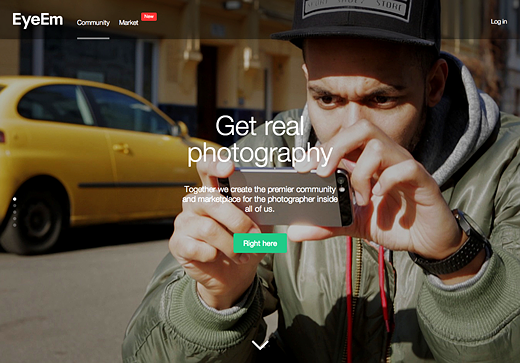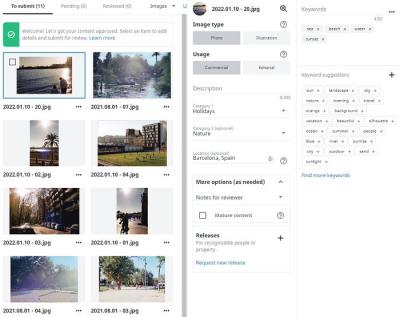In today’s digital world, stock photography has become a major way for photographers to earn money from their work. Platforms like EyeEm and Shutterstock are popular choices for artists looking to showcase their images and generate income. But how do these platforms compare in terms of sales frequency? If you’re wondering where your photos might perform better or how often you can expect to see sales, it’s worth exploring how these two giants operate and what influences their sales dynamics. Let’s dive into what makes each platform unique and how they stack up against each other in the world of stock photography.
Understanding EyeEm and Shutterstock Sales Performance

When it comes to sales performance, EyeEm and Shutterstock each have their own strengths and quirks. Shutterstock is one of the biggest names in the industry, boasting an extensive library of millions of images and a massive global customer base. Because of this, many photographers see consistent sales, especially if their photos are popular or niche-specific. For example, images that align with trending topics, seasonal themes, or high-demand categories tend to sell more often on Shutterstock. The platform operates on a royalty split model, where contributors earn a percentage of each sale, typically ranging from 15% to 30%, depending on your contributor level and sales volume. This means that with a large catalog of high-quality images, you can expect steady income, but it might take some time to build up that portfolio.
EyeEm, on the other hand, has a slightly different approach. It’s known for its community-driven vibe and focus on authentic, artistic, and fresh visuals. EyeEm’s marketplace is integrated with other stock platforms and has a curated selection process that emphasizes quality and uniqueness. Sales on EyeEm can sometimes be less frequent than on Shutterstock, especially for newer contributors or images that don’t fit the most in-demand categories. However, EyeEm often rewards photographers whose images resonate with current trends or have a distinctive style. Additionally, EyeEm’s partnership with brands and agencies can occasionally lead to higher-value licensing deals, which might not happen as often but can be more lucrative when they do. Overall, while Shutterstock might offer more frequent sales due to its size, EyeEm can be a great platform for photographers who excel in creative, authentic imagery and are willing to be patient for those higher-value sales.
In the end, your sales frequency on either platform depends on multiple factors, including your niche, quality of images, keyword optimization, and engagement with the community. Many successful stock photographers maintain portfolios on both sites to maximize their exposure and income potential. Understanding the unique sales performance of each platform helps you tailor your strategy and set realistic expectations as you grow your stock photography business.
Factors Influencing Sales Frequency on EyeEm and Shutterstock

When it comes to selling your photos online, understanding what influences your sales frequency can really help you optimize your efforts. Both EyeEm and Shutterstock are popular platforms, but they each have their quirks and unique audiences. So, what factors play a role in how often your images get purchased on these sites?
1. Audience and Market Demand: The type of buyers that frequent each platform can make a big difference. Shutterstock has a massive global audience that includes everything from small businesses to large corporations, which means there’s a steady demand for a wide variety of images. EyeEm, on the other hand, tends to attract more creative professionals and brands looking for more authentic, artistic, or trendy visuals.
2. Photo Quality and Style: Both platforms prioritize high-quality images, but EyeEm is especially known for its curated collection of artistic and lifestyle shots. If your style aligns with these trends, your photos might sell more frequently on EyeEm. Shutterstock is more accepting of a broader range of styles, but the competition is fierce, so standing out with unique, sharp, and relevant images is key.
3. Keywording and Metadata: Properly tagging and describing your images significantly impacts discoverability. On both platforms, well-optimized keywords help your photos appear in relevant searches. However, Shutterstock’s search algorithm tends to be more sophisticated, rewarding detailed and accurate metadata.
4. Licensing Options and Pricing: The way your images are licensed can influence how often they sell. Shutterstock offers various licensing options, including standard and enhanced licenses, which can appeal to different buyers. EyeEm’s licensing tends to be more straightforward but still offers opportunities for higher-value sales when your images are used in campaigns.
5. Upload Frequency and Portfolio Size: Consistently uploading new images can keep your portfolio fresh and increase visibility. Shutterstock rewards active contributors with higher rankings in search results, while EyeEm’s curated approach means quality often trumps quantity, but a larger portfolio still helps.
In summary, factors like audience preferences, image quality, metadata, licensing options, and your activity level all influence how often you make sales on EyeEm versus Shutterstock. Understanding these nuances allows you to tailor your photography and marketing strategies accordingly.
Comparison of Revenue Potential and Sales Volume
Now, let’s talk about the big picture—how do EyeEm and Shutterstock compare when it comes to earning potential and the number of sales? If you’re serious about making money from your photography, knowing the differences can help you decide where to focus your efforts.
Sales Volume: Shutterstock, with its enormous user base and diverse customer needs, typically results in a higher volume of sales for contributors. Many photographers report hundreds or even thousands of downloads over time. Because of its vast library and active marketplace, your images can get found and purchased frequently, especially if you upload regularly and optimize your keywords.
EyeEm’s sales volume tends to be lower but more specialized. The platform’s curated approach means fewer images are available, but those images often cater to niche markets or artistic projects that pay higher licensing fees. This can lead to fewer sales overall but potentially more lucrative ones.
Revenue Potential: While the volume might be higher on Shutterstock, the earning per sale is generally lower—think in the range of a few dollars per download. Shutterstock operates on a royalty system where contributors earn a percentage based on their earnings tier, which increases with sales volume.
EyeEm, on the other hand, often offers higher payouts per sale, especially for images used in advertising campaigns or featured projects. The platform’s licensing model can sometimes lead to larger one-time payments, which boosts your overall earning potential per sale.
Here’s a quick comparison:
| Aspect | Shutterstock | EyeEm |
|---|---|---|
| Sales Volume | Higher, due to larger user base and diverse content | Lower, but niche and targeted |
| Average Earnings per Sale | $0.25 – $2.00 (varies with license type) | Higher, often $10 or more per licensing |
| Revenue Potential | Dependent on volume; can generate steady income | Potential for higher payouts per sale, especially in campaigns |
| Best For | Photographers seeking consistent, volume-based income | Artists wanting higher-value licensing opportunities |
Ultimately, if your goal is to generate regular income through a large number of smaller sales, Shutterstock might be the better platform. If you prefer to target high-paying, specific projects or clients, EyeEm can offer more lucrative opportunities per sale. Many successful contributors choose to diversify their presence across both platforms to maximize their earning potential and sales volume.
Tips to Increase Sales on Both Platforms
So, you’re wondering how to boost your sales on EyeEm and Shutterstock? Great question! While each platform has its unique quirks, there are some universal strategies that can help you get more eyes on your images and, ultimately, more sales. Let’s dive into some practical tips you can start applying today.
1. Optimize Your Keywords and Tags
Both EyeEm and Shutterstock rely heavily on search to connect buyers with the right images. Think about what your ideal customer might search for and use relevant, specific keywords. Be descriptive but avoid overstuffing. For example, instead of just “flower,” try “vibrant sunflower in summer field.” The more accurate your tags, the higher your images will rank in search results.
2. Focus on Quality Over Quantity
High-quality images stand out. Invest in good equipment and pay attention to lighting, composition, and post-processing. Clear, sharp, and visually appealing photos are more likely to be purchased. Remember, both platforms favor images that look professional and are technically sound.
3. Study Trending Topics and Popular Niches
Keep an eye on what’s trending—whether it’s remote work, sustainability, or health & wellness. Creating images that align with current trends can significantly increase your chances of making sales. Browse popular collections on both platforms to see what’s in demand.
4. Regularly Upload Fresh Content
Consistency is key. The more fresh images you upload, the higher your chances of appearing in search results and recommendations. Set a manageable goal, like uploading a few new images each week, to keep your portfolio active and engaging.
5. Engage with the Platform Community
Comment on other photographers’ work, participate in contests, and follow trending topics. This can increase your visibility and help you stay connected with what buyers are looking for. Some platforms also reward active contributors with better exposure.
6. Use Both Platforms Strategically
While Shutterstock might be better for broad commercial content, EyeEm’s community-driven approach can be great for creative and niche images. Tailor your uploads accordingly—use EyeEm to showcase creative projects and Shutterstock for more generic, high-demand stock photos.
By applying these tips, you’ll be well on your way to increasing your sales on both EyeEm and Shutterstock. Remember, patience and consistency are key—building a successful stock photography side hustle takes time, but the effort pays off!
Conclusion and Final Thoughts on Choosing the Right Platform
Choosing between EyeEm and Shutterstock—or deciding to use both—ultimately depends on your goals, your style, and where you want to focus your efforts. Let’s do a quick recap to help you decide what’s best for you.
EyeEm is fantastic if you’re into more creative, community-driven projects. Its unique curation process and focus on artistic expression can give your work a platform that values originality. Plus, EyeEm’s licensing options can be flexible, making it appealing for photographers looking for diverse ways to monetize their images.
Shutterstock, on the other hand, is a powerhouse in the stock photography world. It boasts a vast customer base and a straightforward licensing model, which can translate into higher sales volume for popular images. If your goal is to generate consistent income from a wide range of commercial content, Shutterstock might be the better pick.
Here’s a quick comparison:
| Feature | EyeEm | Shutterstock |
|---|---|---|
| Community Focus | High – encourages creative collaboration and community engagement | Moderate – mainly a marketplace with less community interaction |
| Content Style | Creative, artistic, niche | Commercial, broad, versatile |
| Sales Potential | Variable – depends on niche and community engagement | Generally high for popular categories |
| Ease of Use | Intuitive platform, but more curated | Streamlined upload process with extensive customer base |
Ultimately, the best approach might be to leverage both platforms. Use EyeEm to showcase your creative side and connect with a community of like-minded artists, while relying on Shutterstock for steady, high-volume sales of commercial images. Consistency, quality, and strategic keywording are your best friends no matter where you upload.
Remember, the world of stock photography is constantly evolving. Keep experimenting, stay updated on trends, and don’t be afraid to adjust your strategy. With time and persistence, you’ll find what works best for you—and enjoy the journey of turning your passion into profit!


